16.12.2013
China to launch Chang'e-5 space vehicle with moon rover on board in 2017
China positions rocket ahead of ambitious lunar mission
China has moved a massive rocket into place in preparation for launching a mission to bring back materials from the moon for the first time in four decades
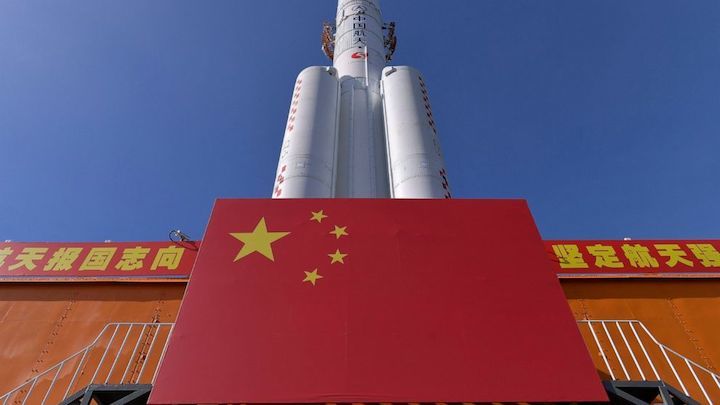
In this July 17, 2020, file photo released by China's Xinhua News Agency, a Long March-5 rocket is seen at the Wenchang Space Launch Center in south China's Hainan Province. China on Tuesday, Nov. 17, 2020, moved the massive rocket into place in preparation for launching a mission to bring back materials from the moon for the first time in four decades. (Zhang Gaoxiang/Xinhua via AP, File)
BEIJING -- China on Tuesday moved a massive rocket into place in preparation for launching a mission to bring back materials from the moon for the first time in four decades.
The Long March-5 was transported by tractor from its hangar to the nearby launch site at the space base in Wenchang along the coast of the southern island province of Hainan.
The Chang’e 5 mission it will carry is scheduled to launch early next week, placing a lander on the moon that will drill 2 meters (almost 7 feet) beneath the surface and scoop up rocks and other debris to be brought to earth. That would allow scientists to study newly obtained lunar materials for the fist time since the American and Russian missions of the 1960s and 1970s.
The mission, named for the Chinese moon goddess, is among China's most ambitious as its space program continues to build steam since it first put a man in space in 2003, becoming only the third nation to do so after the U.S. and Russia.
China currently has a mission on the way to Mars, along with a rover on the moon's far side that is providing the first full measurements of radiation exposure from the lunar surface, information vital for any country that plans to send astronauts to the moon.
China has increasingly engaged with foreign countries on missions, although U.S. law still prevents collaboration with NASA, excluding China from partnering with the International Space Station. That has prompted China to work on its own space station and launch its own programs that have put it in a steady competition with Japan and India among Asian nations seeking to notch new achievements in space.
The space program has progressed cautiously, with relatively few setbacks in recent years. The Long March-5, nicknamed “Fat 5” because of its bulky shape, failed on a previous launch attempt, but China's enormous pool of technical and engineering talent appears to have allowed it to overcome most obstacles.
Quelle: abcNews
+++
China rolls out Long March 5 rocket to launch Chang’e-5 lunar sample return mission
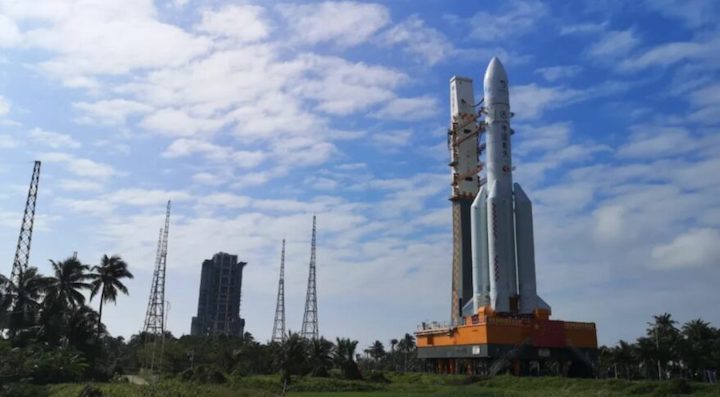
HELSINKI — China has rolled out a Long March 5 heavy-lift rocket in preparation for launch of the complex Chang’e-5 lunar sample return mission early next week.
The roughly 878-metric-ton heavy-lift Long March 5 was vertically transferred from an assembly building to its launch area late Monday Eastern in a process that took around two hours.
Launch of the 8.2-metric-ton Chang’e-5 spacecraft from the coastal Wenchang Satellite Launch Center is now expected Nov. 24 local time. State media reports have so far only confirmed the launch will take place in late November.
A successful mission would make China only the third country to deliver lunar samples to Earth, after the U.S. Apollo crewed program and Soviet robotic Luna missions of the 1960s and 1970s.
Launch preparations at Wenchang have been ongoing since mid-September. The fourth and mostly recent Long March 5 mission rocket successfully launched the Tianwen-1 Mars spacecraft in July.
The Failure of the second Long March 5 launch in July 2017 meant a delay of three years for Chang’e-5, having been scheduled to launch later that year.
Mission landing site, time frame
The Chang’e-5 landing will target a site close to Mons Rümker, a volcanic formation situated in the Oceanus Procellarum region of western edge of the near side of the moon.contains geological units as young as around 1.21 billion years old. By comparison samples brought to Earth by Apollo astronauts are aged between 3.1 and 4.4 billion years old.
Sunrise over Mons Rümker will occur November 27, ahead of the landing attempt. The mission seeks to collect around 2 kilograms of samples by both drilling to a depth of up to two meters and scooping up surface material.
Unlike China’s ongoing, multi-lunar-day Chang’e-4 spacecraft which is equipped with radioisotope heater units to survive the extreme cold of lunar night, the Chang’e-5 landing and sampling needs to take place within a single, roughly 14-Earth-day lunar daytime.
After sampling, a complex ascent, automated lunar orbit rendezvous and transfer of materials involving separate ascent and service modules will take place. The service module will then return to Earth followed by a high-velocity reentry into Earth’s atmosphere by a return capsule.
The mission is expected to last around 23 days from launch until landing in Siziwang Banner, Inner Mongolia, around Dec. 16-17. Samples will then be transferred to specially developed facilities for handling, analyzing and storing the lunar material.
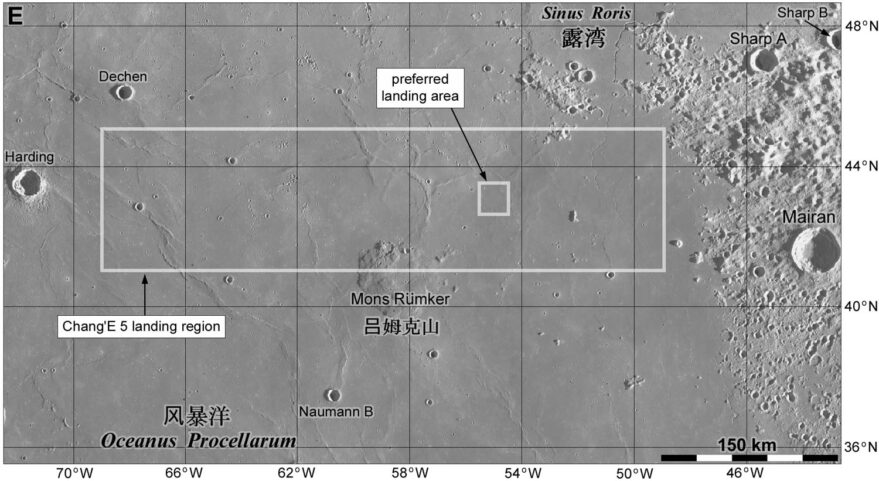
Greater challenges
Chang’e-5 is the third phase of the Chinese lunar exploration project formulated in the early 2000s. Orbiters Chang’e-1 and 2 and subsequent landing and roving missions Chang’e-3 and 4 marked the first two stages.
Yu Dengyun, deputy chief designer of China’s lunar exploration program, told state media in September that the mission is much more challenging than previous missions.
New challenges include the sampling and following stages. “The gravity on the Moon is different from that on the Earth, about one sixth. And under such a circumstance, how to package samples is a key issue of the mission. We have never tried that before,” Yu said.
“We usually completed the rocket launching on the Earth at a fixed point. We have a proven technique in this field. But we still have difficulties in the liftoff of the ascend vehicle, which is expected to happen on the lander…we have never tried this before,” said Yu.
Chang’e-6 is a sample return spacecraft engineered at the same time as Chang’e-5 to provide a backup in the event of failure. Success of the latter would however see Chang’e-6 repurposed for a landing at the lunar south pole around 2023.
China has stated it will then proceed into an extended phase of lunar exploration involving Chang’e-7and further lunar landing missions. The aim will be to establish an ‘international lunar research station’ in the mid-to-late 2020s as a precursor to crewed landings.
Sample return technology and experience developed through Chang’e-5 is also to be utilized for planned near Earth asteroid and Mars sample return missions later in the decade. The complexity of the Chang’e-5 mission profile is considered by observers to be related to future crewed lunar landing ambitions.
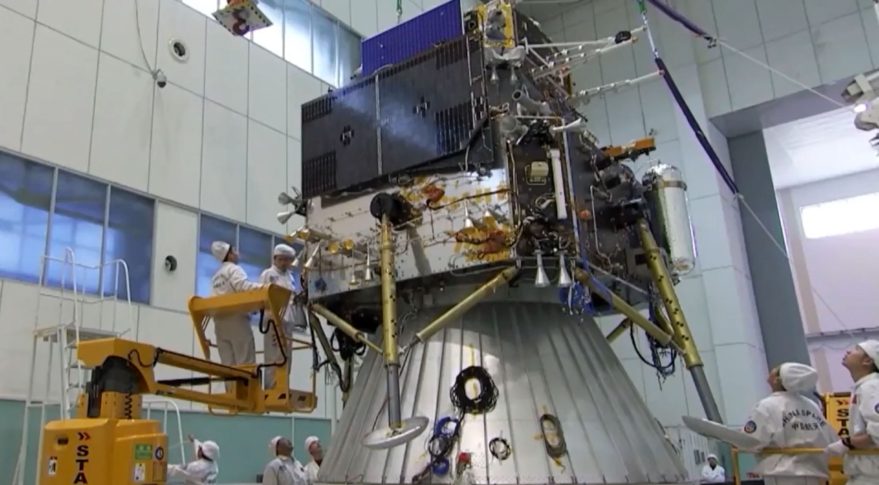
China prepares to launch Long March-5 rocket for Chang'e-5 mission
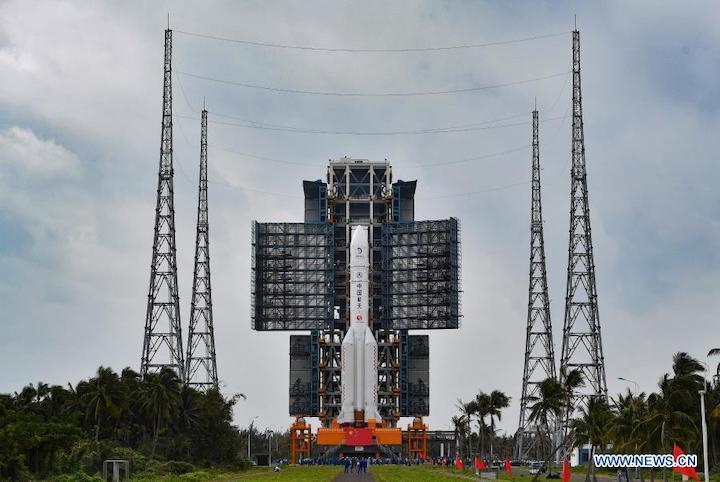
Photo taken on Nov. 17, 2020 shows the Long March-5 Y5 rocket at the Wenchang Spacecraft Launch Site in south China's Hainan Province. The fifth Long March-5 rocket, to be used to launch China's Chang'e-5 lunar probe, was vertically transported to the launching area at the Wenchang Spacecraft Launch Site on Tuesday. The carrier rocket is planned to be launched in late November, according to the China National Space Administration. (Xinhua/Guo Cheng)
The fifth Long March-5 rocket, to be used to launch China's Chang'e-5 lunar probe, was vertically transported to the launching area at the Wenchang Spacecraft Launch Site in south China's Hainan Province on Tuesday.
The carrier rocket, coded as Long March-5 Y5, is planned to be launched in late November, according to the China National Space Administration.
Space engineers have conducted a general assembly and tests on the rocket after it was transported to Wenchang in late September.
It took about two hours to vertically transport the large rocket to the launching area Tuesday morning. Final examinations and tests will be conducted on the rocket before the launch.
The Long March-5 carrier rocket, currently China's largest launch vehicle, successfully launched China's first Mars mission Tianwen-1 on July 23.
The Chang'e-5 mission aims to conduct unmanned lunar sample collection and return to Earth, one of the country's most complicated and challenging space missions. It will contribute to the scientific studies in fields such as the formation and evolution of the moon. Enditem
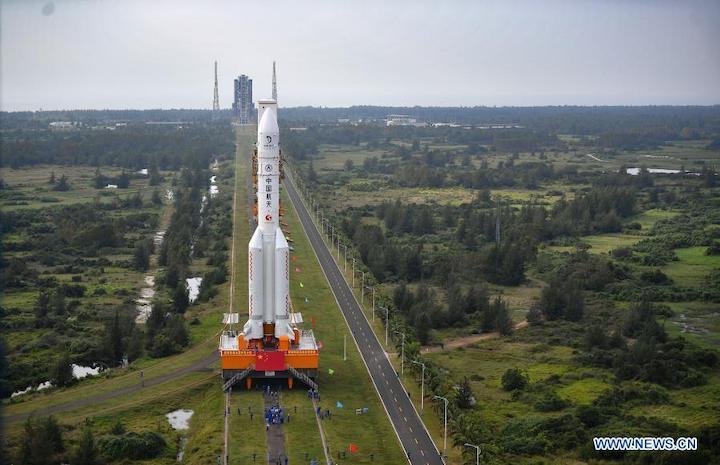
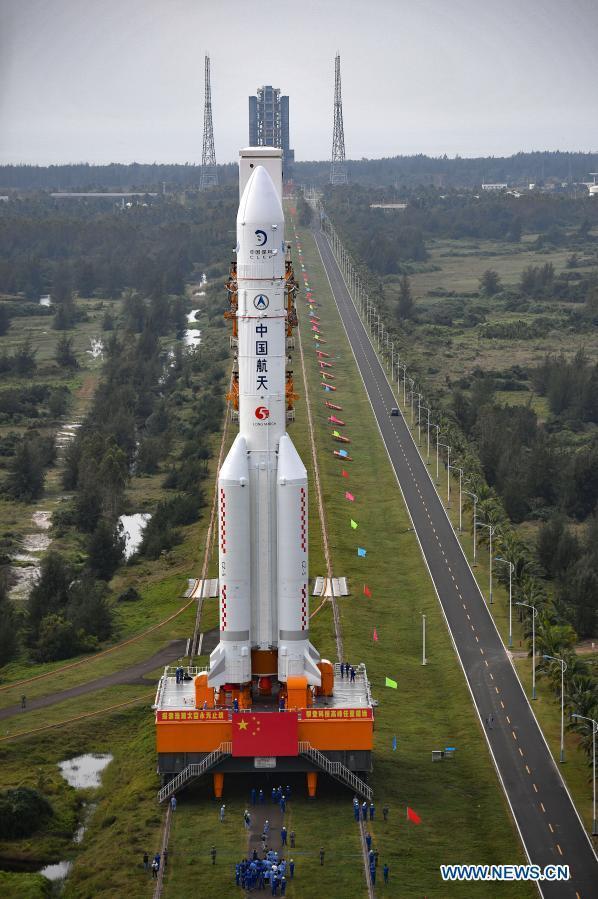
Quelle: Xinhua
----
Update: 20.11.2020
.
China Prepares to Launch Its Most Ambitious Moon Mission Yet
Another big step for the current world leaders in lunar exploration.
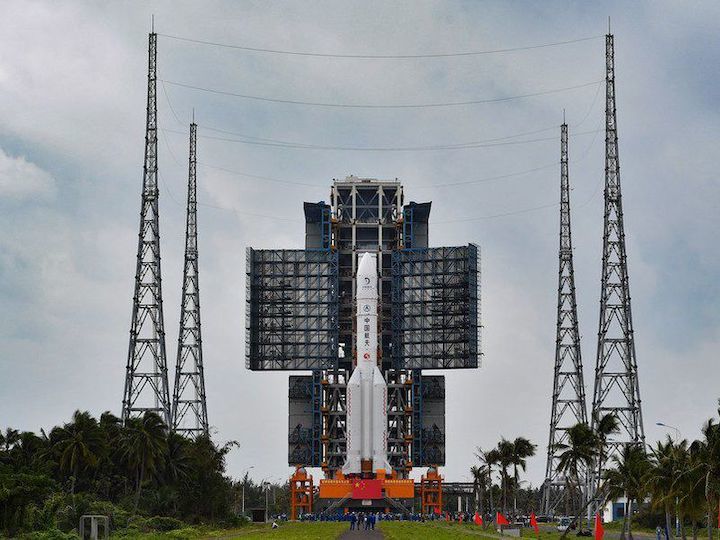 .
.Now, with its third moon lander, China plans an even more ambitious step—a robotic mission to collect samples of lunar soil and return them to Earth for the first time since the Apollo era. Scheduled to launch on November 24 onboard a modified Long March 5 heavy lift rocket, Chang’e-5 is targeted to land autonomously in Oceanus Procellarum, the Ocean of Storms. Its goal is to collect two kilograms of rubble and dirt from a relatively young (less than two-billion year-old) region near Mons Rümker, a bulging mountain that rises 1,300 meters above the plain, surrounded by more than 20 rounded lava domes. The lander will use a drill and a robotic arm with a scoop to pick up material in its immediate vicinity—no rover this time—and will have just one lunar day, or two weeks on Earth, to complete its work.
The launch of Chang’e-5 was delayed nearly three years after a Long March turbopump malfunctioned in 2017, causing the rocket and its communications satellite to crash into the ocean a few minutes after liftoff. Next week’s launch should benefit from nearly three years of YF-77 engine redesigns and two successful Long March missions since the accident, including the launch of the Tianwen 1 probe to Mars last July.
Chang’e-5 will be the first lunar sample return since the robotic Soviet Luna 24 mission in 1976. But this mission is more than just a repeat, and will feature multiple innovations, including ground penetrating radar to reveal the substructure of Mons Rümker and a coring drill able to extract cores at least two meters deep with all layers preserved.
Most advanced of all will be the return to Earth, starting with the liftoff of Chang’e-5’s ascent vehicle and its store of core samples from the surface, followed by an automated docking with a service capsule in lunar orbit. The core samples will then be transferred to a return capsule, which will execute a “one-skip” reentry procedure upon arrival at Earth, bouncing off the upper atmosphere to slow down and enable a safe landing in Inner Mongolia’s Siziwang Banner, the same pastoral site where Shenzhou astronaut crews have landed. The return is planned for mid-December.
All these steps are deemed essential to China’s plans for future exploration of the moon, which include a small robotic lunar research station—possibly with international partners—scheduled for later this decade, followed eventually by astronaut landings.
“The Chinese are not naïve enough to say [these missions] are just for pride and prestige. They want to do good science,” says James Head, a professor of planetary geology at Brown University and coauthor of a 2018 paper on the geological setting for the Chang'e-5 mission. Head is a veteran planetary explorer, having collaborated on U.S., Russian, and Chinese missions going back to the Apollos and Lunas of the 1970s.
Why Mons Rümker? Head and his counterpart in China, Long Xiao, who’s with the Planetary Science Institute at China University of the Geosciences in Wuhan, say the region is anomalous, radioactive and uniquely unexplored. “A relatively smooth site [for landing] with controllable engineering is the first priority,” Xiao explained in an email. “But for science, we did not want to return the same or similar samples as the Apollo and Luna missions. The Rümker region was targeted [because] this is different from the previous landing and sampling sites and hasn’t been explored in situ.” Xiao suggests the volcanic deposits around Rümker may hold the key to understanding the moon’s origins and evolution.
The region where Chang’e-5 will touch down has half the impact craters and much more recent lava flows than either the Apollo 11 or 12 sites, which also were in flat plains. How can one part of the moon be so much younger than the other, and by billions of years? No one knows, exactly. Remote sensing suggests that the Rümker area has high amounts of radioactive thorium, which according to one model, may have heated up the moon’s mantle enough to form the basaltic flows. “That’s why Chang’e-5 is going there, [because] we need to bring back the samples and measure them,” explains Head, who teaches graduate students at the Chinese University of Geosciences at Wuhan during summers. Once the new samples are evaluated and dated, he says, “we can go back and calibrate the [age estimations] for other celestial bodies—Venus, Mars, and Mercury, for example—and that could change our thinking about all the planets over the last few billion years.”
The robotic Chang’e missions have been a great success for China’s evolving lunar program, which has solid government funding and multiple academic collaborations. “This is not a pedal-to-the-metal, go go go ‘let’s-put-a-person-on-the-moon [program],’” observes Dean Cheng, a senior research fellow for Chinese political and security affairs at the conservative Heritage Foundation in Washington. “There are many aspects to the Chinese program—major powers do science, for example—but also recognition that space benefits the Chinese economy” in areas such as advanced materials, systems engineering, power storage, communications technology, and radar. “If you do a lot of space things, you promote key industrial areas,” says Cheng.
As China builds its space program, it has already chalked up a number of firsts. In 2018 the country launched a lunar communications relay satellite, Queqiao (meaning “Bridge of Magpies”) positioned at a libration point behind the moon, which allowed Chang’e-4 to communicate with Earth from the lunar far side. “This is important because no other country has deployed an ‘application’ satellite [of this type],” Cheng says.
Is this part of a plan to somehow conquer the moon? Not likely, Cheng insists, since the country is a signatory to the Outer Space Treaty, which calls for the peaceful, shared use of space. “I don’t see the Chinese laying claim to the moon any more than the U.S. did with Apollo,” he says. But, like their counterparts in the United States and Europe, “certain elements in China are talking about an Earth-moon-space economy zone to develop and exploit.”
NASA will be following the Chang’e-5 mission closely, even though it is not a direct participant. “The key scientific advance…is simply the return of an actual sample from one more area of the moon…[and] every data point is valuable,” says David Williams, who heads the agency’s Space Science Data Coordinated Archive at the Goddard Space Flight Center. “Since there hasn’t been a sample returned from the moon since 1976, and only three samples ever returned robotically, this will be a good demonstration of using the latest technology…which will be a useful example for any country planning a lunar sample return mission after over 40 years.”
NASA plans to send its own small lander missions to the moon starting as early as next year, and has a stated—although highly optimistic—goal of landing astronauts by 2024. But China doesn’t see it as a race, and isn’t focused on “What are the Americans doing now?” says Head. “The leaders of the Chinese National Space Agency believe they’re building a silk road in space. From a leadership point of view, they’re doing the same thing as Apollo—planting a human on the moon and returning him safely at the end of the decade. But with the Chinese, it’s broader. [They’re] not perturbed by short-term [setbacks.] Culturally, it’s a long-term view of history.”
Quelle: Air&Space
+++
China's space tracking ship sails for Chang'e-5 mission
China's second-generation space tracking ship Yuanwang-3 left here Thursday for missions concerning the Chang'e-5 lunar probe, according to sources with the country's satellite maritime tracking and controlling department.
China's Chang'e-5 mission, which is scheduled to be launched late this month, will bring moon samples back to Earth, making it one of the country's most complicated and challenging space explorations.
Yuanwang-3 mainly undertakes maritime tracking and monitoring tasks of high-, medium- and low-orbit satellites, spacecraft and space stations.
Since it was launched more than 20 years ago, the ship has made more than 50 voyages and completed 89 missions on the sea, including tracking of the Shenzhou spacecraft, the Chang'e lunar probe and BeiDou satellites, maintaining a 100 percent success rate.
Two other tracking ships, Yuanwang-5 and Yuanwang-6, have also sailed out for their missions. The departures of these ships indicate that the Yuanwang fleet's maritime missions this year are coming to a close.
Since the beginning of 2020, vessels of the Yuanwang fleet, sailing over 150,000 nautical miles, have performed monitoring missions of the last BeiDou satellite and China's first Mars probe, as well as transporting missions of the Long March carrier rockets. Enditem
Quelle: Xinhua
----
Update: 23.11.2020
.
China's space tracking ship sails for Chang'e 5 mission
![]()
China's second-generation space tracking ship Yuanwang 3 left here Thursday for missions concerning the Chang'e 5 lunar probe, according to sources with the country's satellite maritime tracking and controlling department.
China's Chang'e 5 mission, which is scheduled to be launched late this month, will bring moon samples back to Earth, making it one of the country's most complicated and challenging space explorations.
Yuanwang 3 mainly undertakes maritime tracking and monitoring tasks of high-, medium- and low-orbit satellites, spacecraft and space stations.
Since it was launched more than 20 years ago, the ship has made more than 50 voyages and completed 89 missions on the sea, including tracking of the Shenzhou spacecraft, the Chang'e lunar probe and BeiDou satellites, maintaining a 100 percent success rate.
Two other tracking ships, Yuanwang 5 and Yuanwang 6, have also sailed out for their missions. The departures of these ships indicate that the Yuanwang fleet's maritime missions this year are coming to a close.
Since the beginning of 2020, vessels of the Yuanwang fleet, sailing over 150,000 nautical miles, have performed monitoring missions of the last BeiDou satellite and China's first Mars probe, as well as transporting missions of the Long March carrier rockets.
Quelle: SD
----
Update: 23.00 MEZ
-
Start von Chinas return vehicle Change-5 Mission
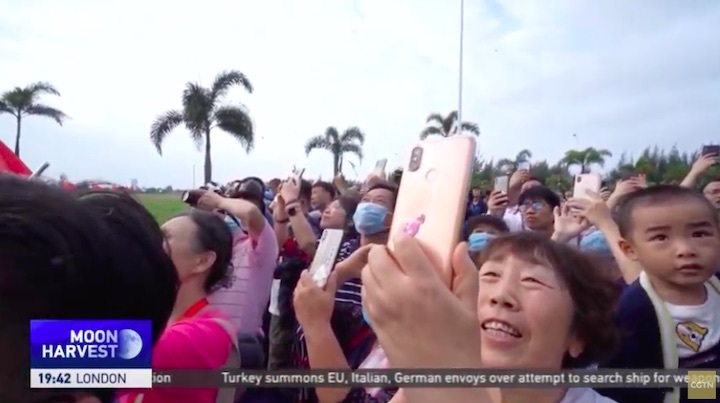
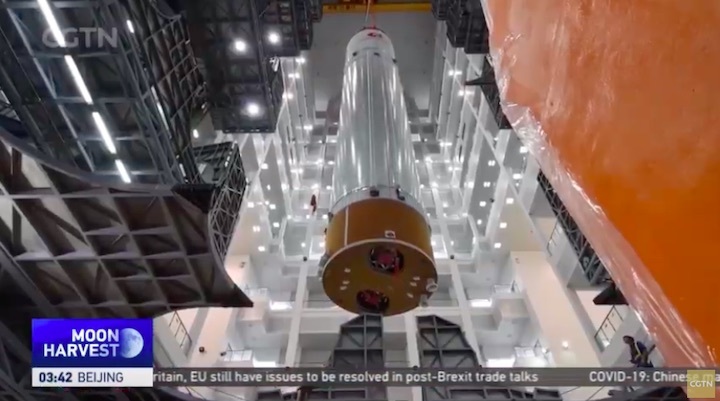

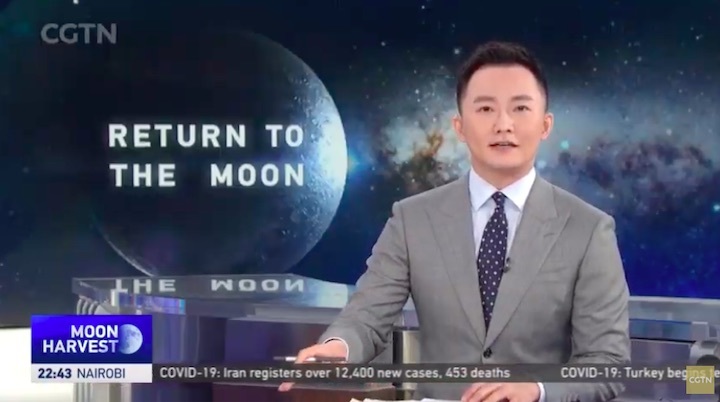
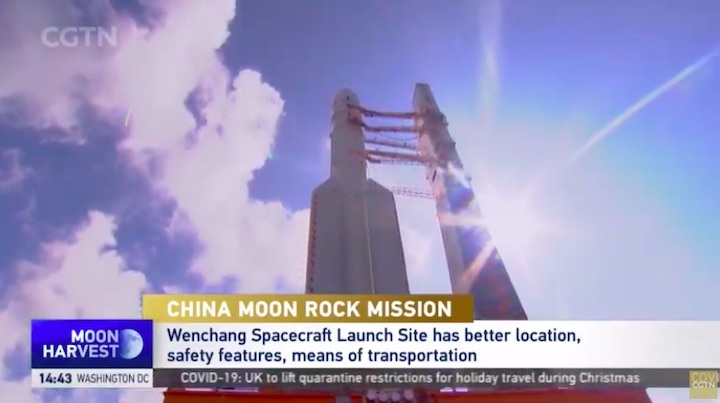
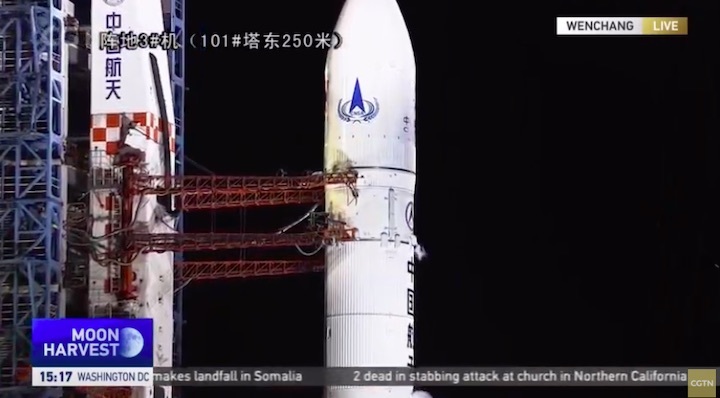
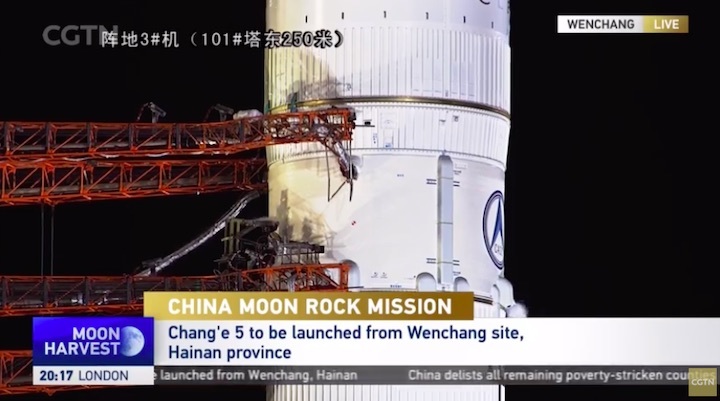
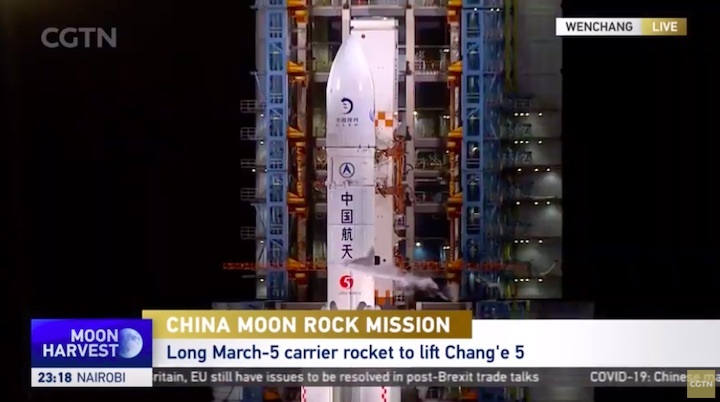
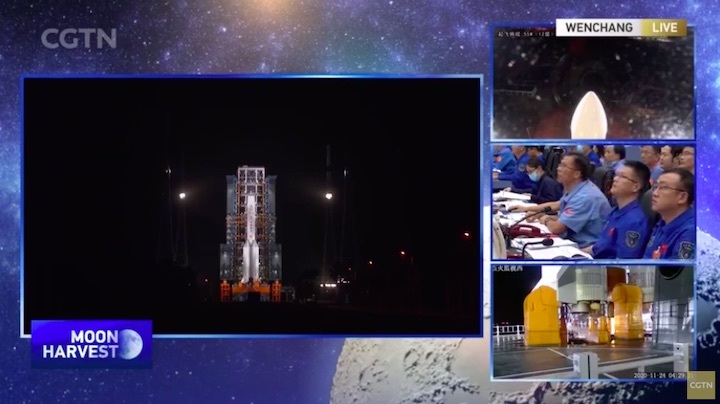
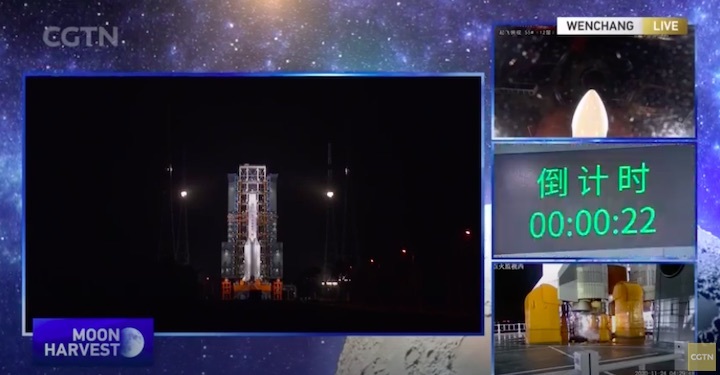
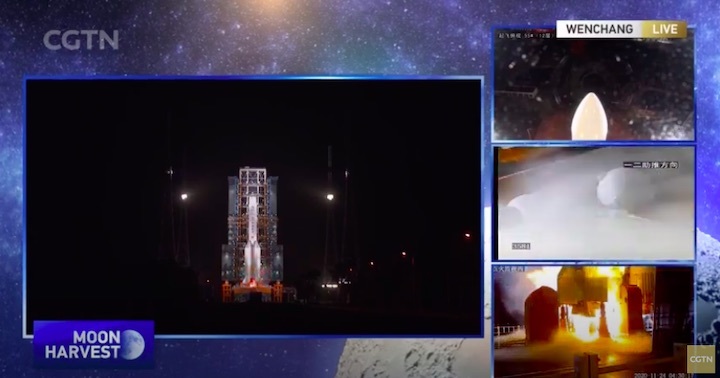
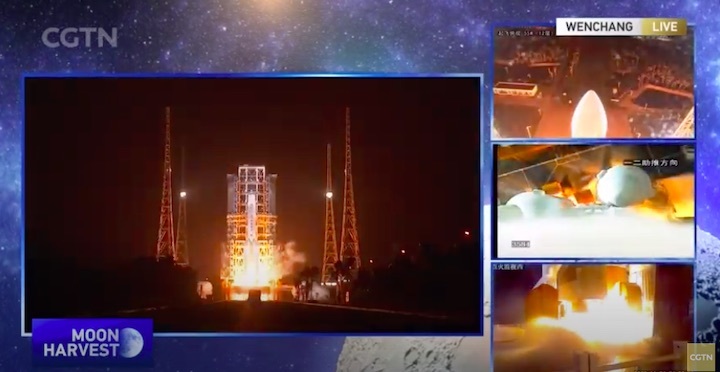
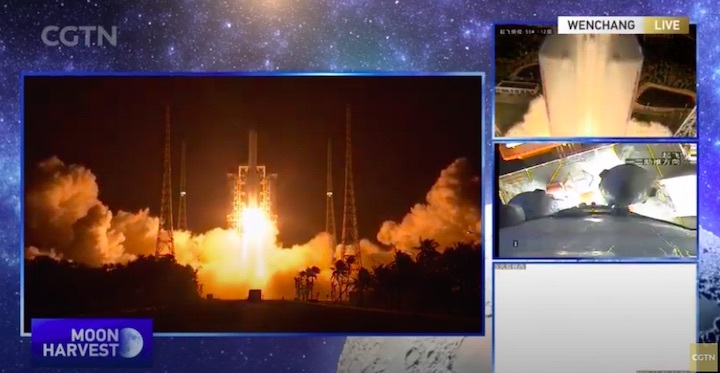
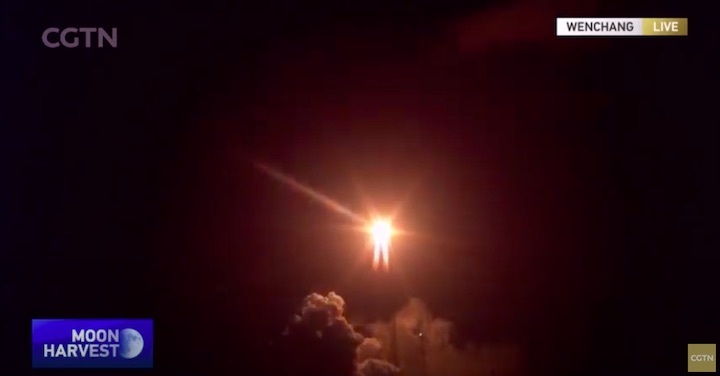
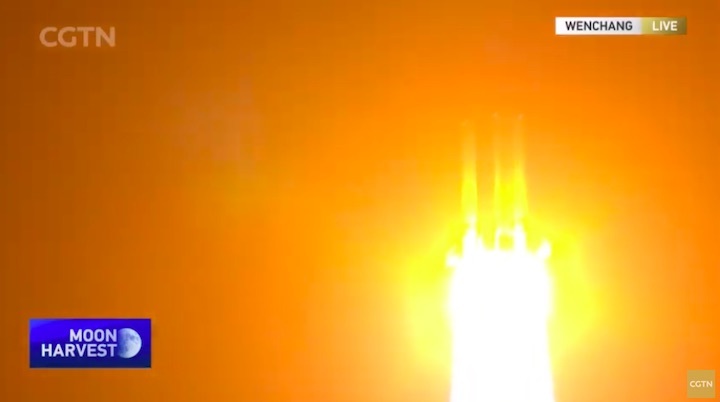
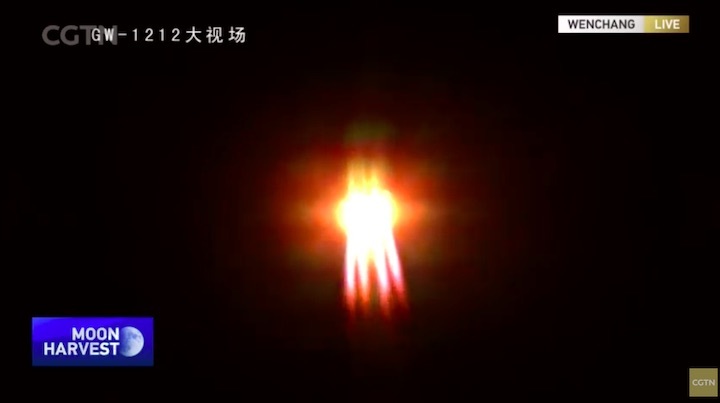
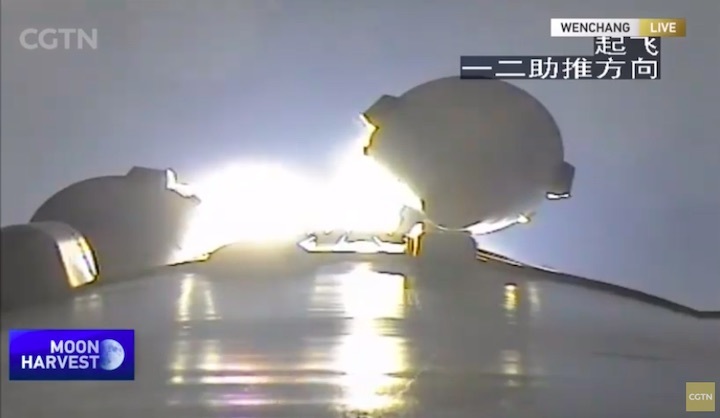
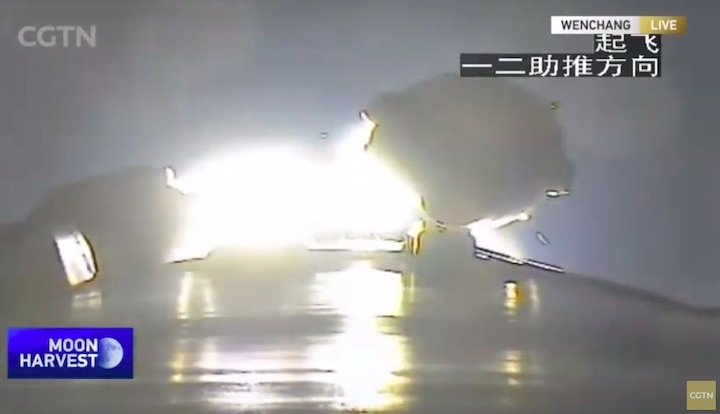
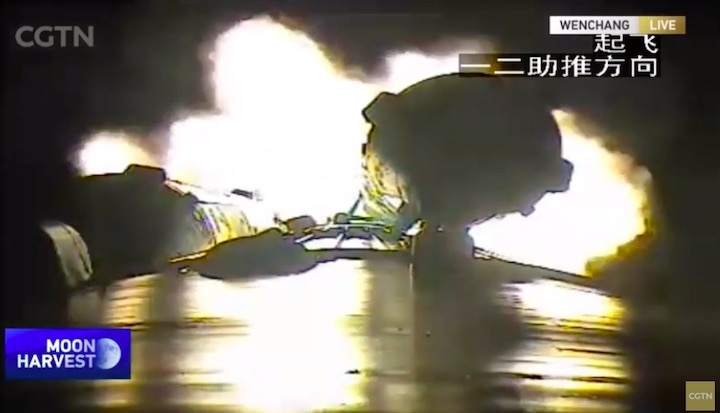
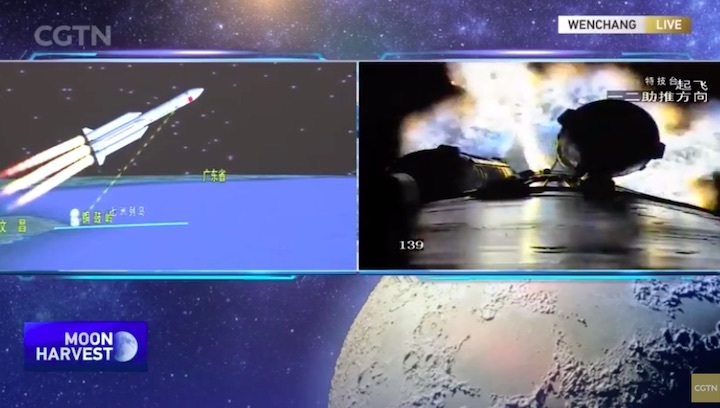
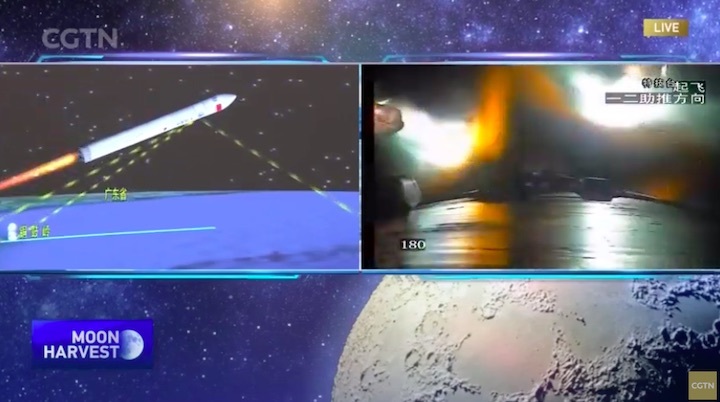
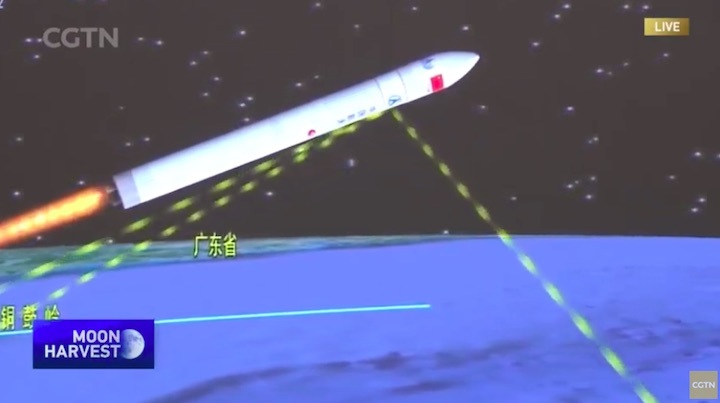
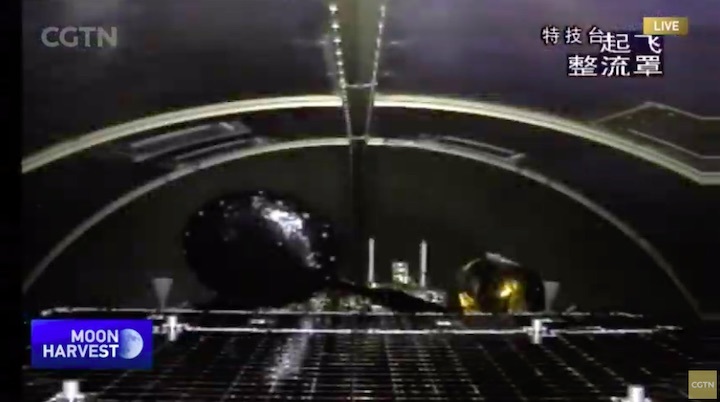
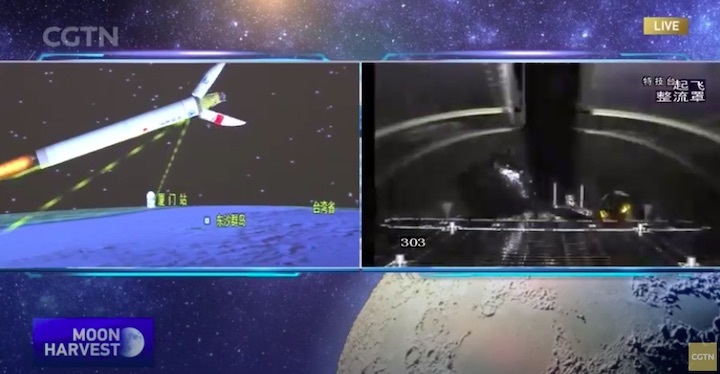
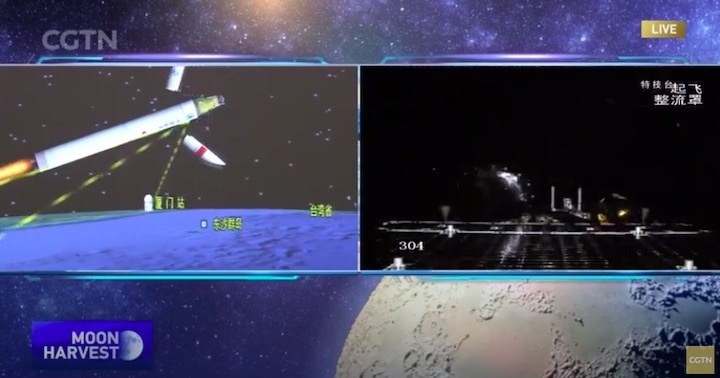
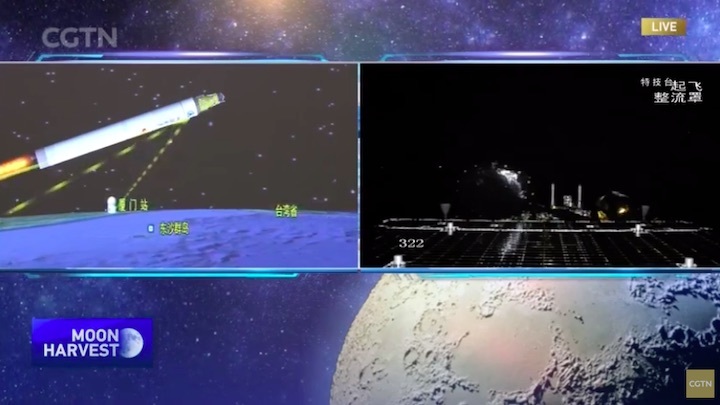
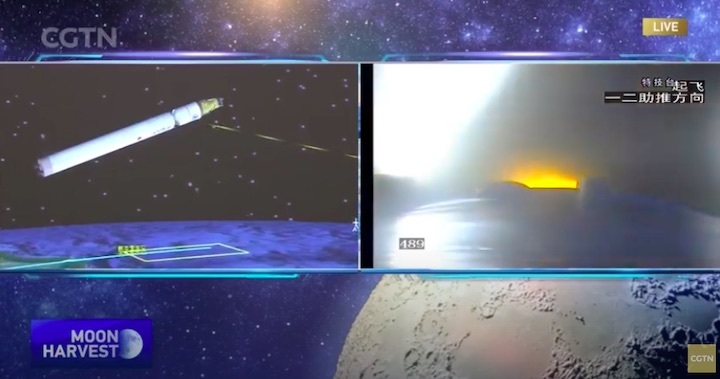

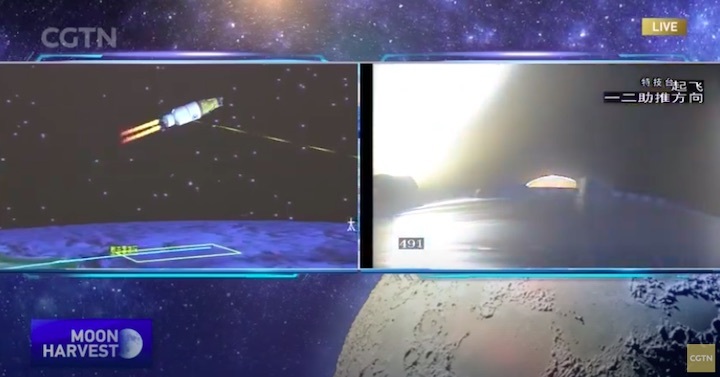
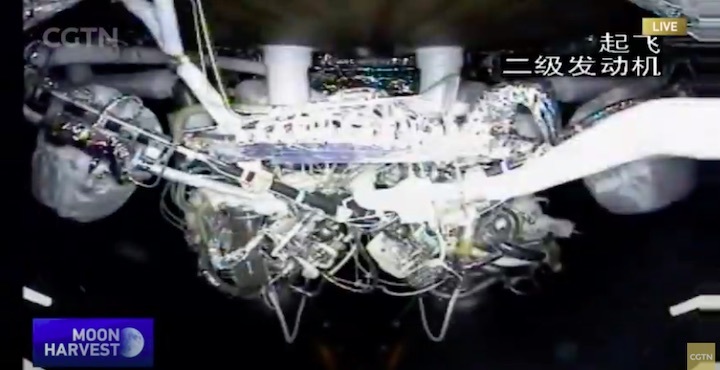
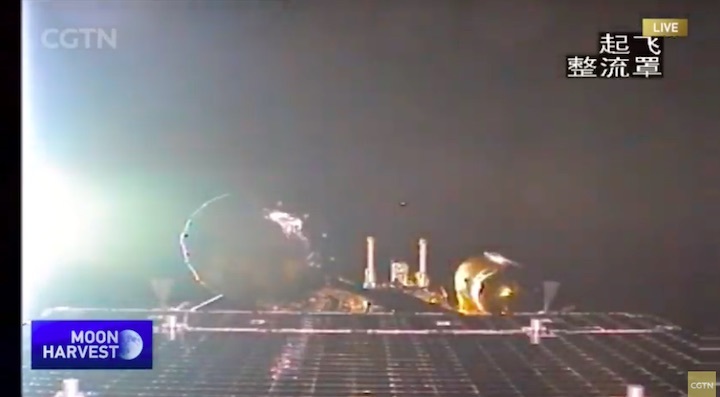
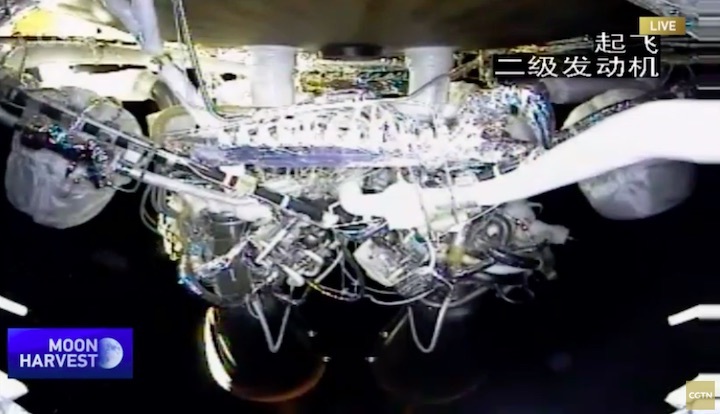
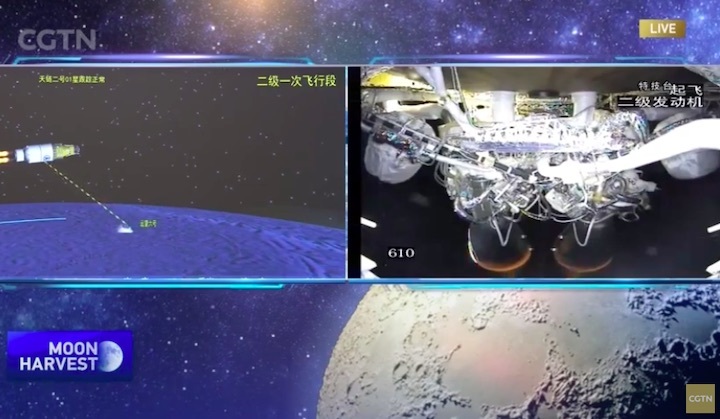
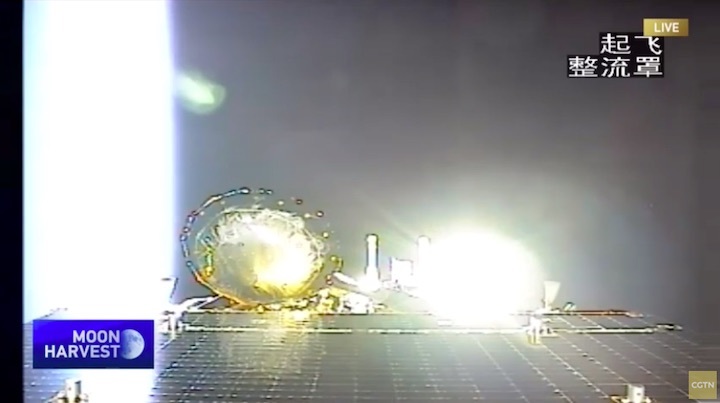
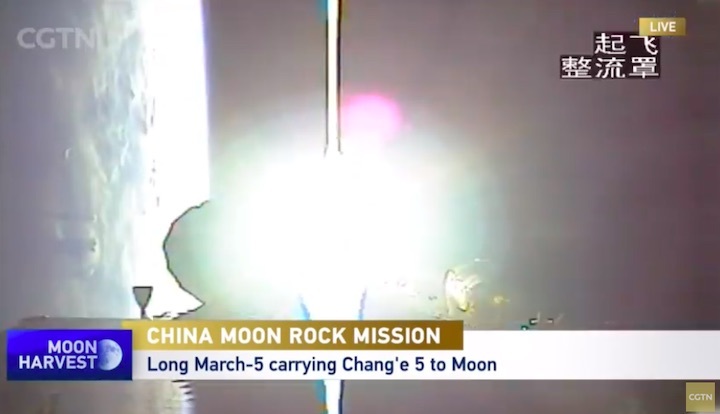
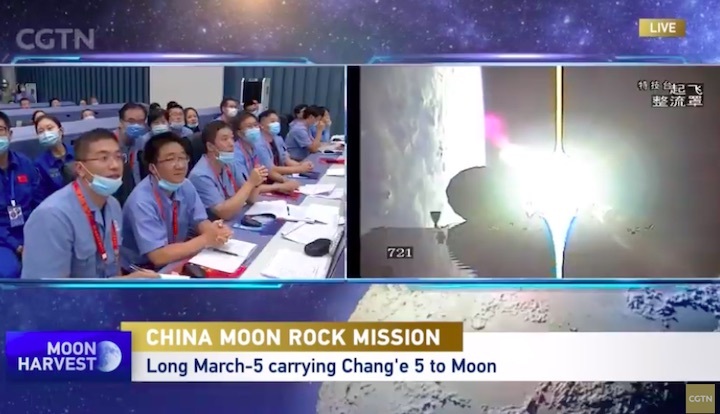
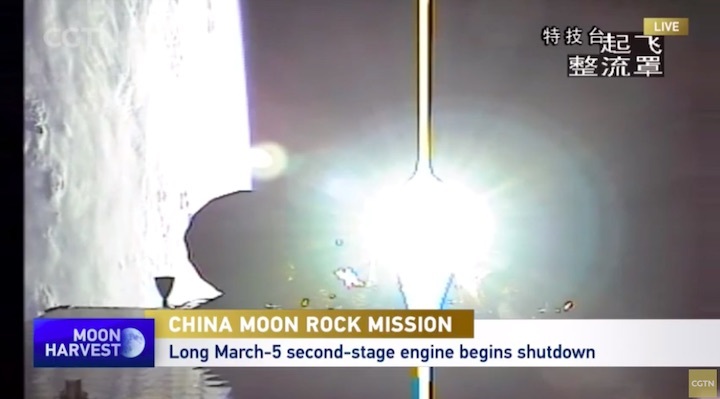
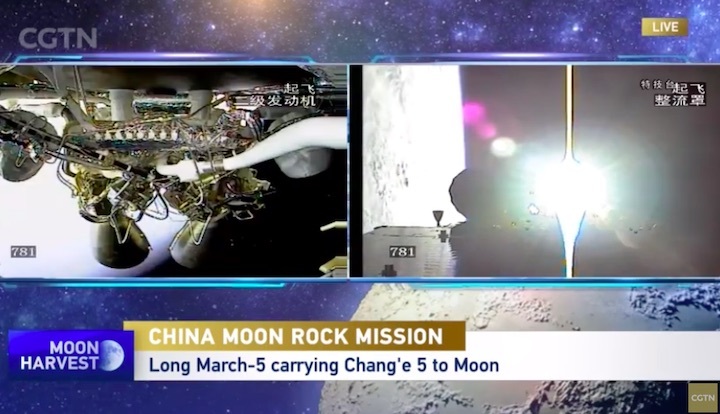

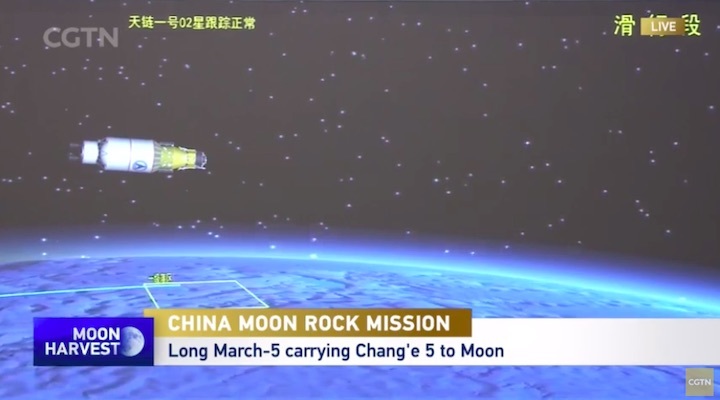
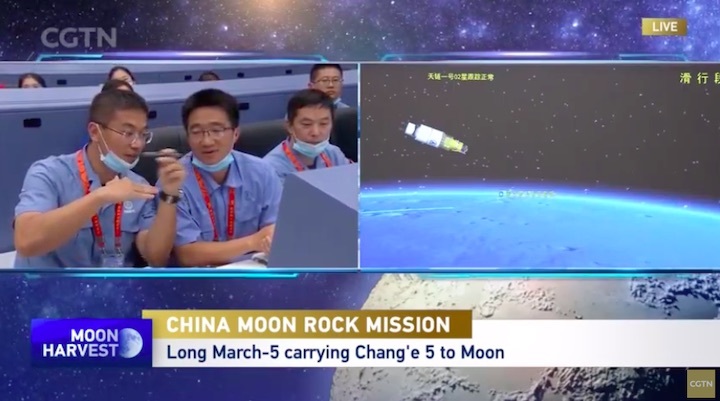
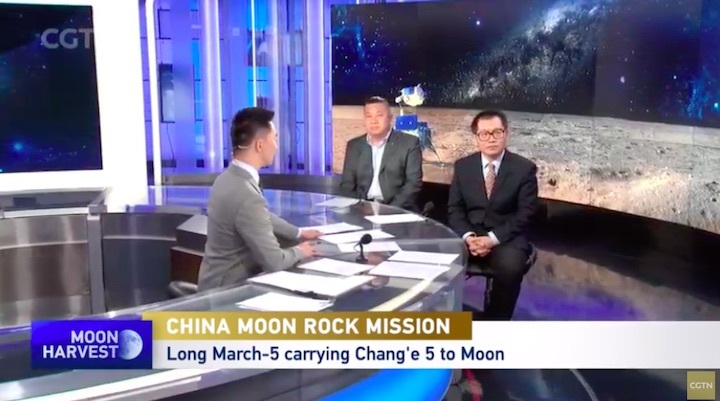
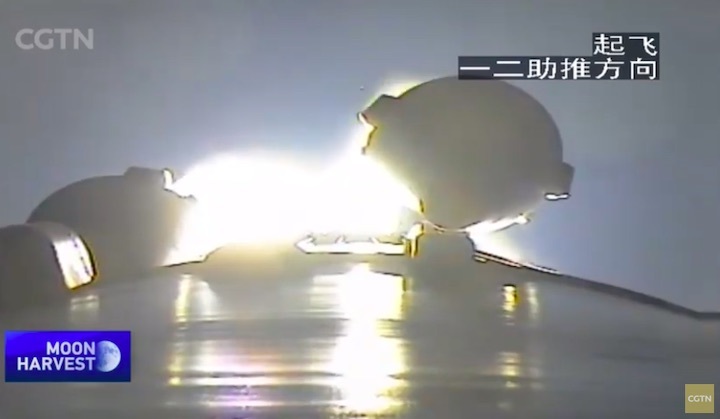
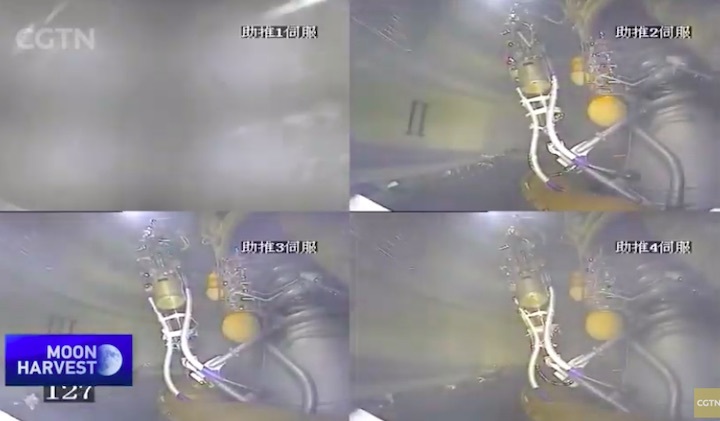
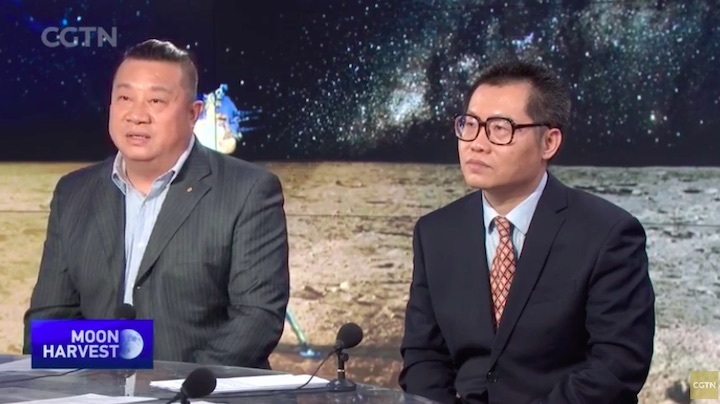
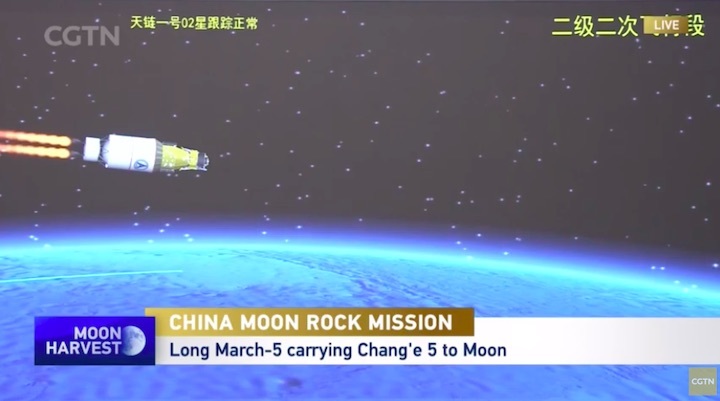
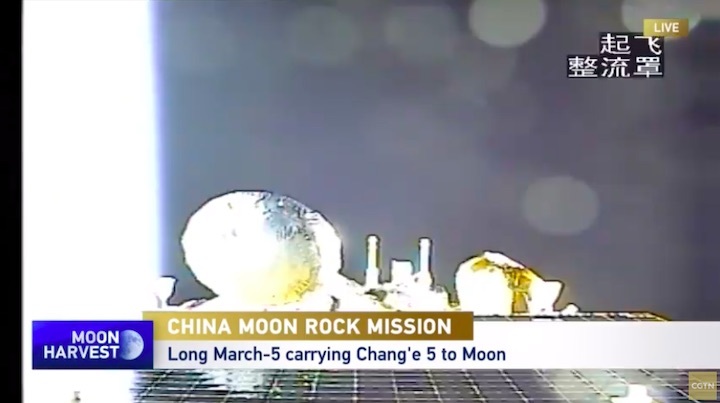
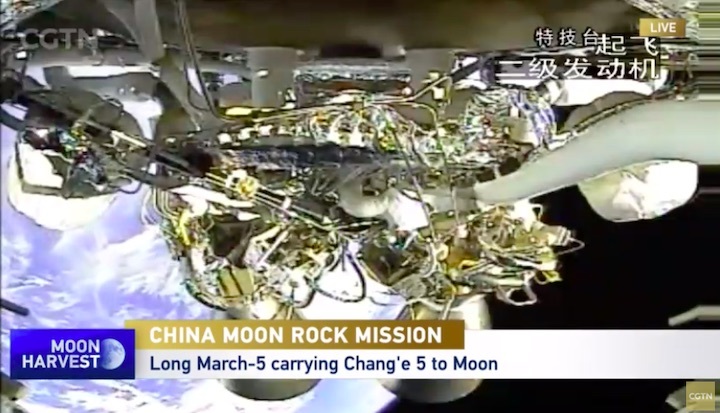
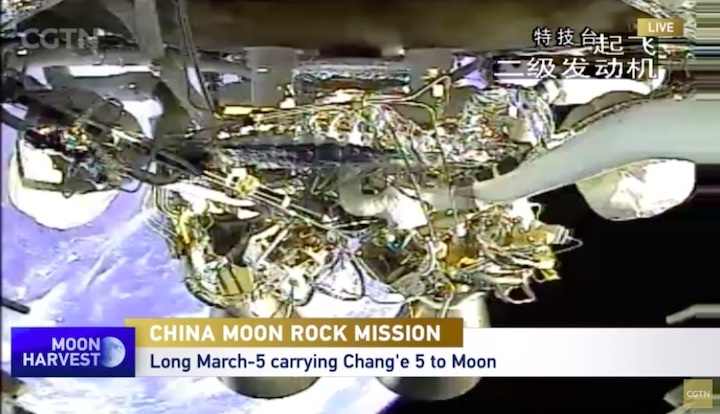
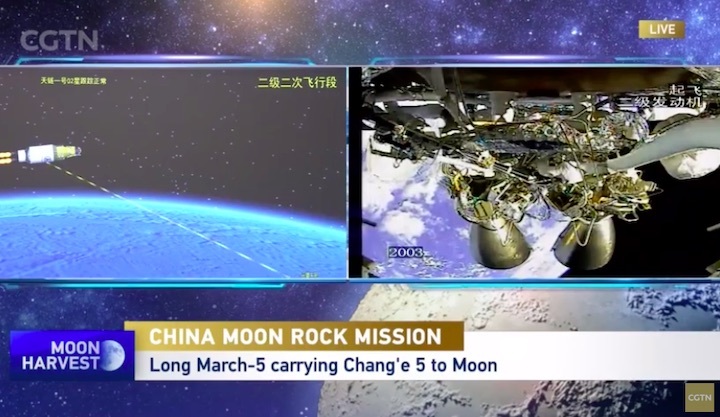
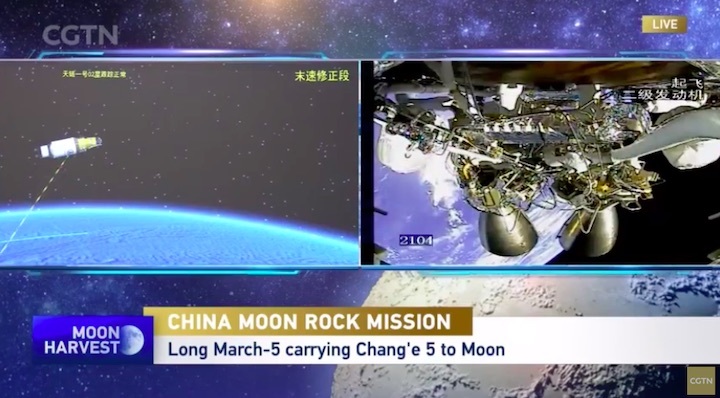
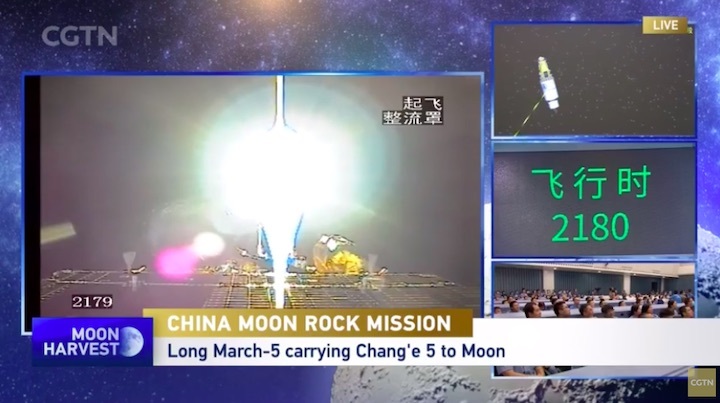
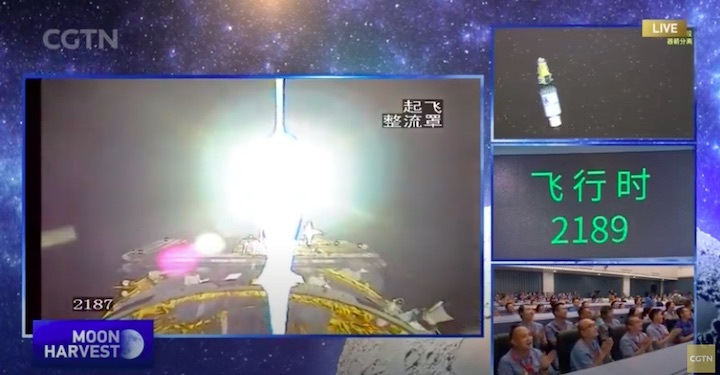
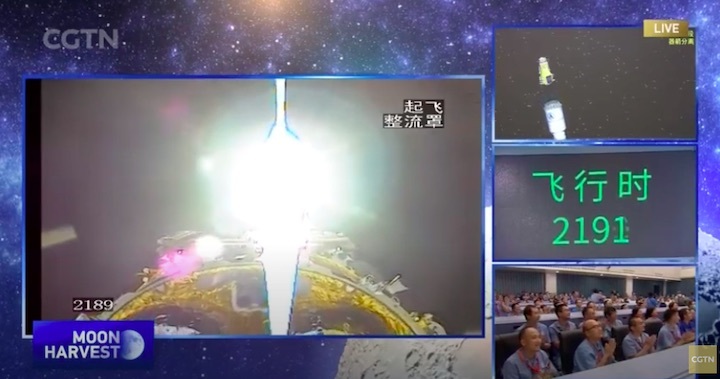
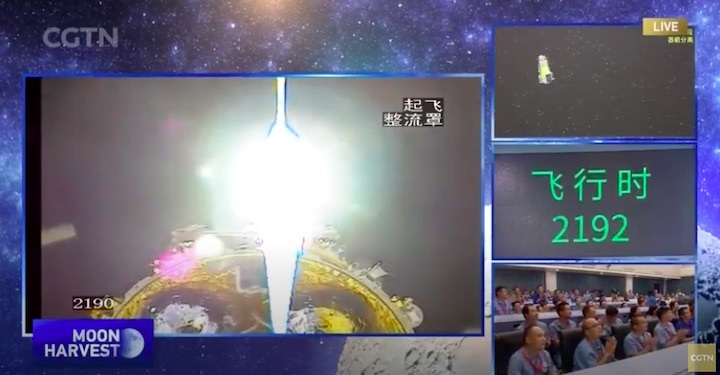
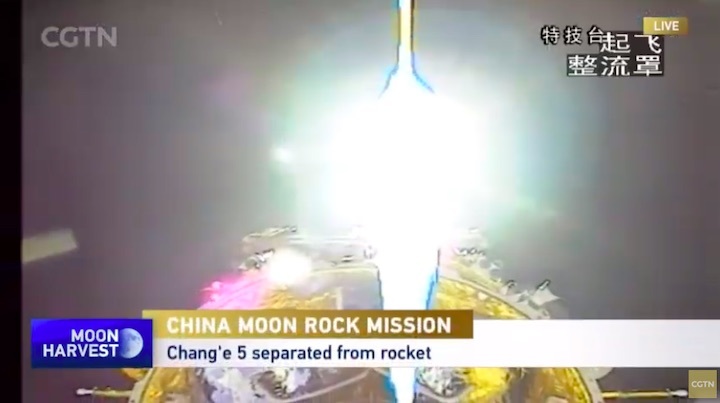
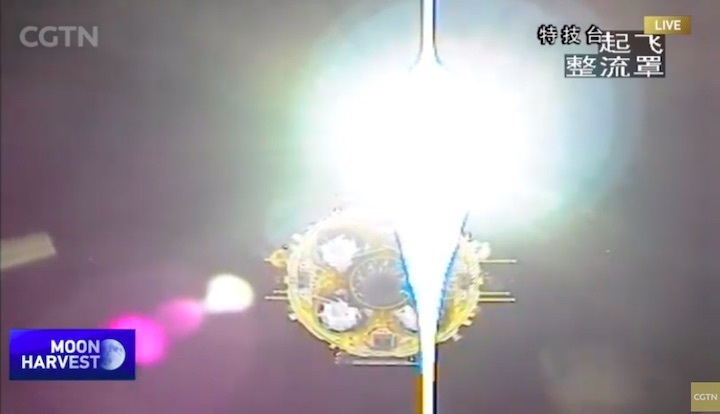
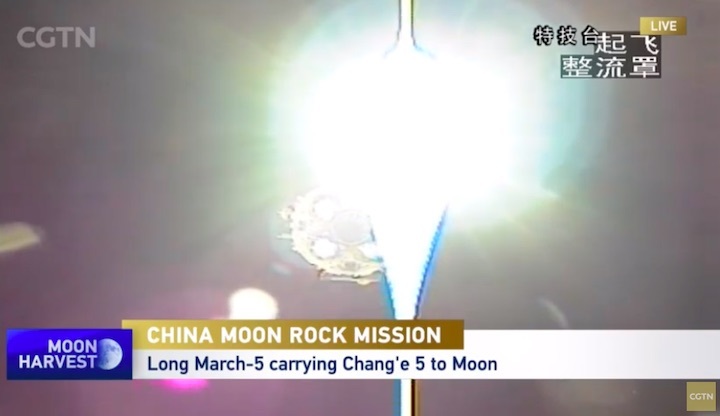
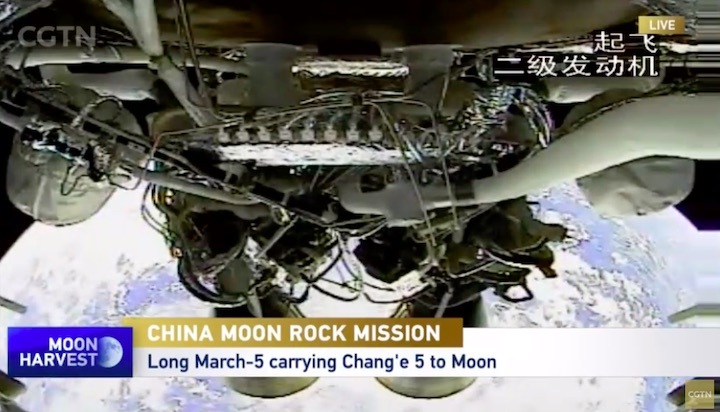
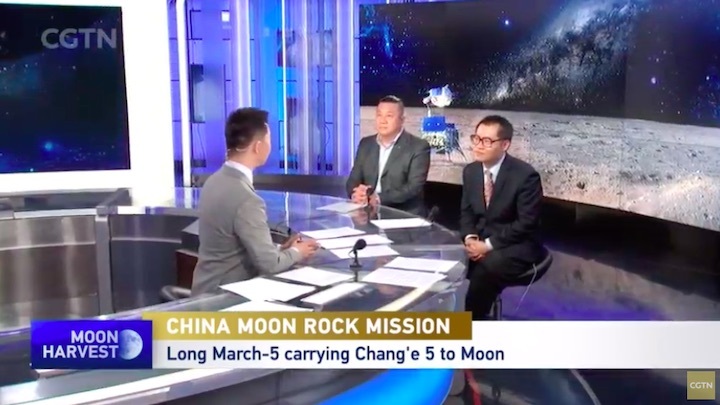
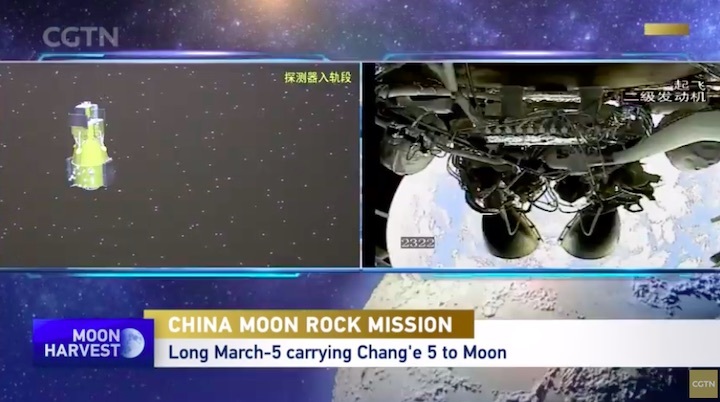
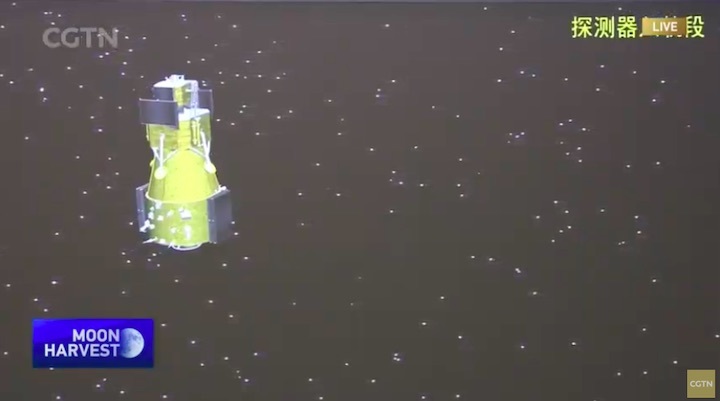
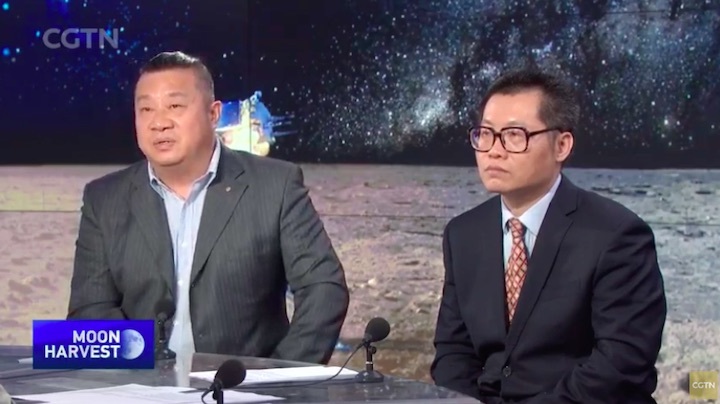
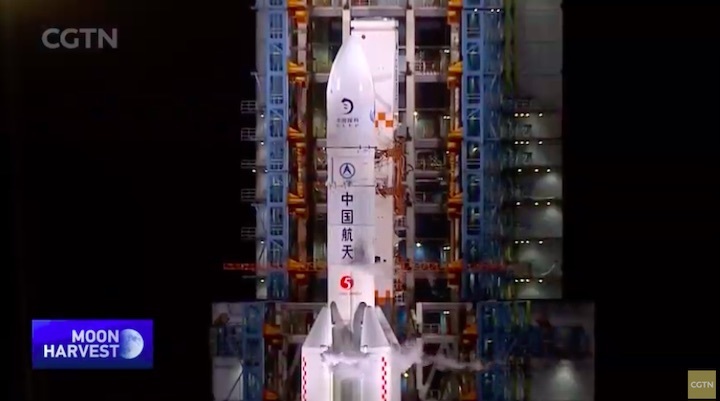
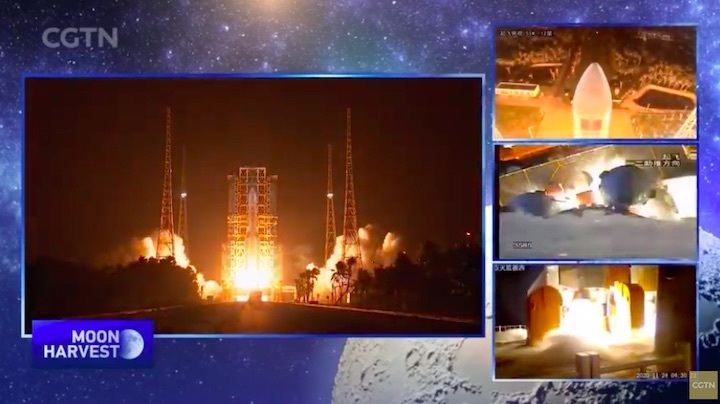
Quelle: CGTN
+++
Update: 24.11.2020
Lunar mission is latest milestone in China's space ambitions
China’s latest trip to the moon is another milestone in the Asian powerhouse’s slow but steady ascent to the stars
WENCHANG, China -- China’s latest trip to the moon is another milestone in the Asian powerhouse’s slow but steady ascent to the stars.
China became the third country to put a person into orbit 17 years ago and the first to land on the far side of the moon in 2019. Future ambitions include a permanent space station and putting people back on the moon more than 50 years after the U.S. did.
But even before the latest lunar mission lifted off before dawn Tuesday, a top program official maintained that China isn't competing with anyone.
“China will set its development goals in the space industry based on its own considerations of science and engineering technology," Pei Zhaoyu, deputy director of the Lunar Exploration and Space Engineering Center at the China National Space Administration, told reporters hours before the Chang'e 5 mission was launched.
“We do not place rivals (before us) when setting those goals,” Pei said.
Whether that is true or not is debatable. China has a national plan aimed at joining the United States, Europe and Japan in the top ranks of technology producers, and the space program has been a major component of that. It also is a source of national pride to lift the reputation of the ruling Communist Party.
What’s clear is that China’s cautious, incremental approach has racked up success after success since it first put a person in space in 2003, joining the former Soviet Union and the United States. That has been followed by more crewed missions, the launch of a space lab, the placing of a rover on the moon’s relatively unexplored far side and, this year, an operation to land on Mars.
The Chang'e 5 mission, if successful, would be the first time moon rocks and debris are brought to Earth since a 1976 Soviet mission. The four modules of the spacecraft blasted off atop a massive Long March-5Y rocket from the Wenchang launch center on Hainan island.
The mission’s main task is to drill 2 meters (about 7 feet) into the moon’s surface and scoop up about 2 kilograms (4.4 pounds) of rocks and other debris. The lander will deposit them in an ascender. A return capsule will deliver them back to Earth, landing on the grasslands of the Inner Mongolia region in mid-December.
“Pulling off the Chang'e 5 mission would be an impressive feat for any nation," said Florida-based expert Stephen Clark of the publication Spaceflight Now.
China prides itself on arriving at this point largely through its own efforts, although Russia helped early on with astronaut training and China's crewed Shenzhou space capsule is based on Russia's Soyuz.
While there has been collaboration with some other nations, notably those belonging to the European Space Agency, which has provided tracking support for Chinese missions, the United States isn't one of them.
U.S. law requires Congressional approval for cooperation between NASA and China's military-linked program. Ongoing political and economic disputes, notably accusations that China steals or compels the transfer of sensitive trade secrets, appear to dim the prospects for closer ties.
China's space program has at times been seen as recreating achievements attained years ago by others, primarily the U.S. and the former Soviet Union. Even China's permanent space station, now under construction, is partly a response to its exclusion from the International Space Station, mainly at the insistence of the U.S.
Other countries are also forging ahead, underscored by the dramatic landing of America's Curiosity Mars rover in 2012 and the return to Earth next month of Japan's explorer Hayabusa2 with samples collected from the asteroid Ryugu.
Still, China can boast an “increasingly sophisticated and demonstrated space expertise," said Henry Hertzfeld, director of the Space Policy Institute at George Washington University's Elliot School of International Affairs.
Lunar exploration remains a priority for China, something that in the future will likely take the form of “a human-machine combination,” Pei told reporters.
No target date for a crewed moon mission has been announced, but Pei said a goal down the line is to build an international lunar research station that can provide long-term support for scientific exploration activities on the lunar surface.
“We will determine when to implement a manned lunar landing based on scientific needs and technical and economic conditions," he said.
Quelle: abcNews
----
Update: 26.11.2020
.
China launches ambitious mission to return lunar material to Earth
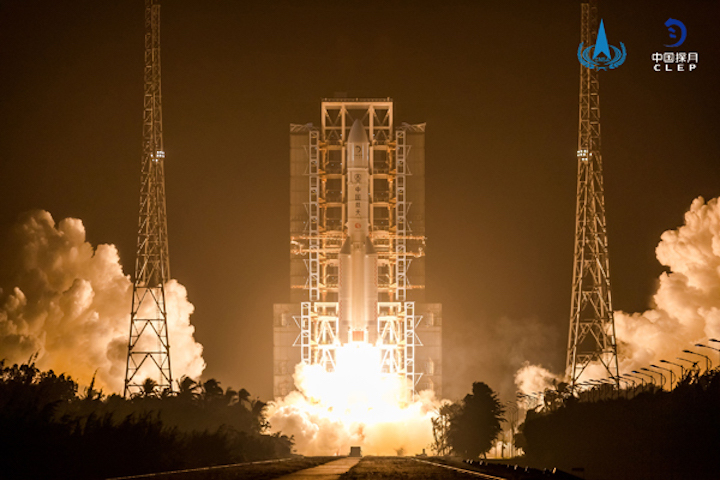
A heavy-lift Long March 5 rocket hurled a 9-ton Chinese spacecraft toward the moon Monday on a 23-day mission attempting to return lunar samples to Earth for the first time in 44 years.
The nearly 20-story rocket fired off its launch pad at the Wenchang space center on Hainan Island in southern China at 3:30 p.m. EST (2030 GMT) Monday with 2.4 million pounds of thrust from 10 liquid-fueled engines.
The Long March 5 rocket is the most powerful launcher in China’s inventory. The launch of the Chang’e 5 lunar sample return mission was delayed by earlier problems with the Long March 5, including a launch failure in 2017 that grounded Long March 5 flights for more than two years.
The rocket worked flawlessly on the launch of Chang’e 5, which occurred at 4:30 a.m. Beijing time Tuesday.
The rocket shed four kerosene-fueled boosters around three minutes after launch, then jettisoned its 17-foot-diameter (5.2-meter) payload shroud after climbing into space. The Long March 5’s cryogenic core stage, powered by two hydrogen-fed main engines, propelled the Chang’e 5 spacecraft to near orbital velocity.
Twin hydrogen-fueled engines performed two burns to power the 18,000-pound (8.2-metric ton) Chang’e 5 spacecraft on a trajectory toward a point a quarter-million miles from Earth, where it will enter orbit around the moon within a few days.
The exact timeline for the mission has not been released by Chinese officials, but the spacecraft is expected to release a lander to touch down near Mons Rümker, a volcanic formation that extends more than 4,000 feet — or about 1,300 meters — above the surrounding lava plains.
Chang’e 5’s landing site is located in the Oceanus Procellarum, or Ocean of Storms, region in the northern hemisphere of the near side of the moon. The touchdown is expected to occur before the end of November, and the surface mission will occur during a two-week window of daylight at the landing site, allowing solar energy to power the spacecraft.
Once on the moon, Chang’e 5 will extract up to 4.4 pounds, or 2 kilograms, of material from a depth of up to 6.6 feet, or 2 meters, below the surface. Then the specimens will launch back into lunar orbit aboard a small rocket, rendezvous with a return craft, and head for Earth.
The return carrier will re-enter the atmosphere at some 25,000 mph, or 40,000 kilometers per hour, significantly faster than a re-enter from low Earth orbit. The capsule will will land around Dec. 15 in China’s Inner Mongolia region, where teams will retrieve the moon specimens and transport the material to a lab for analysis.
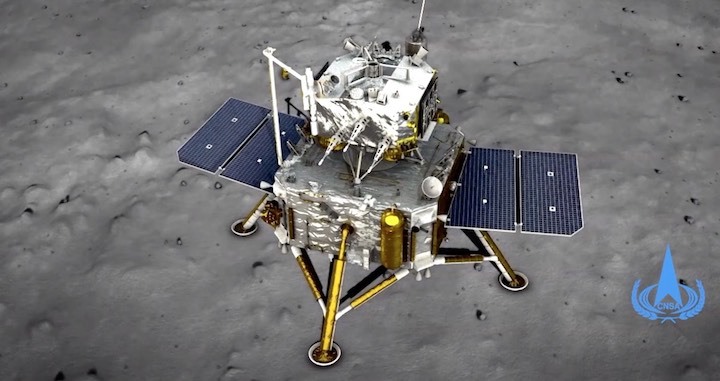
Clive Neal, a lunar scientist at the University of Notre Dame, said China has proven it can land on the moon with previous missions.
“But then they have to collect the sample,” Neal said. “The interesting thing is they launch from the moon, get into lunar orbit, and then rendezvous with the Earth re-entry vehicle that will bring that sample back to Earth safely and uncompromised. When the Soviets did it in 1976, the last time, it was direct to Earth. They launched form the moon and came straight back to Earth. This one has an extra strp in there, which has to go well in order for the sample to actually make it back.
“But given the capability they’ve demonstrated with doing things for the first time, such as the far side landing and roving, I expect things to be successful, and hope they are,” Neal said in an interview with Spaceflight Now.
The sample return mission, if successful, will mark the first time lunar material has been returned to Earth since 1976, when the Soviet Union’s robotic Luna 24 mission brought back around 170 grams, or 6 ounces, of specimens from the lunar surface.
Nine missions have returned moon samples to Earth, including NASA’s six Apollo missions with astronauts, and three robotic Luna spacecraft launched by the Soviet Union. NASA’s Apollo missions brought back 842 pounds (382 kilograms) of rocks from the moon.
There is evidence that rocks in Chang’e 5’s landing zone are much younger than those returned by the Apollo astronauts. Those specimens are some 3.5 billion years old, created during a period of active volcanism in the first billion years of the moon’s existence.
Lava plains to the east of Mons Rümker appear to be less battered by asteroid impacts, suggesting rocks there could be less than 2 billion years old. But models of the moon’s evolution suggest its internal heating should have diminished by that time, rendering volcanoes extinct, Neal said.
“It will be exciting to look at the age of these samples coming back and also the actual compositions of them,” Neal said.
“China is doing a great job here in terms of their first sample return mission,” said James Head, a planetary scientist at Brown University, during remarks broadcast on Chinese state television. “We haven’t been returning samples for 44 years, and we have many scientific questions which the Chang’e 5 mission is going to help us answer. This is really exciting opportunity, and we really appreciate China’s efforts in this area.”
Before Chang’e 5, China has successfully dispatched four robotic explorers to the moon, beginning with the Chang’e 1 and Chang’e 2 orbiters in 2007 and 2010. In 2013, China landed the Chang’e 3 mission on the moon with a mobile rover that drove across the lunar surface.
China’s most challenging lunar mission to date was Chang’e 4, which accomplished the first-ever soft landing on the far side of the moon in January 2019. Chang’e 4’s rover continues operating, sending back imagery and scientific data through a dedicated relay satellite China placed in a position beyond far side of the moon to transmit signals between Earth and the Chang’e 4 spacecraft.
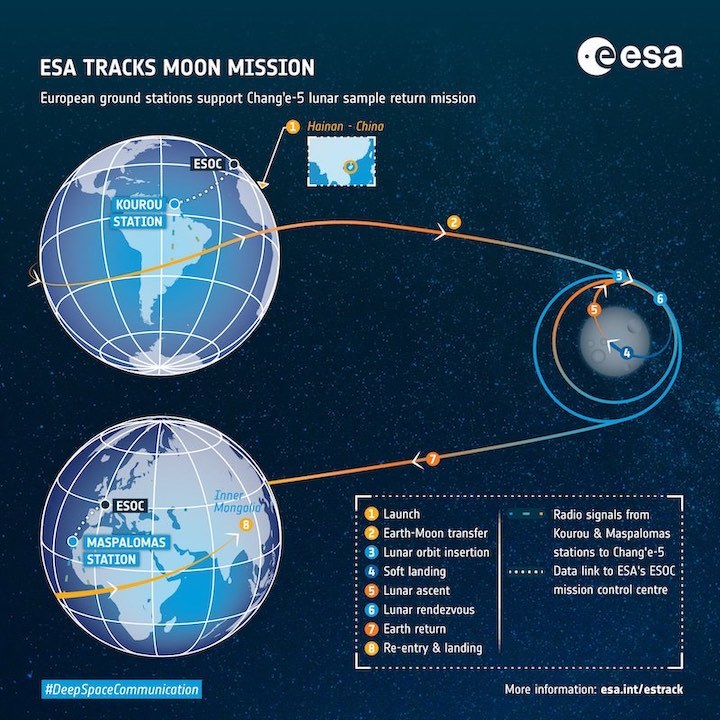
The Chang’e missions are named for a moon goddess in Chinese folklore.
China has a backup to the Chang’e 5 spacecraft named Chang’e 6. If Chang’e 5 is successful, Chang’e 6 could attempt a sample return mission from the far side of the moon.
Unlike Chang’e 5, which is an all-Chinese mission, the Chang’e 6 spacecraft will carry foreign instruments to the lunar surface. The French space agency, CNES, announced last year that it will provide an instrument for the Chang’e 6 mission to study the moon’s exosphere and water cycle.
China is also planning a robotic station on the moon’s south pole before a possible landing on the moon with Chinese astronauts in the 2030s.
Chinese officials have signaled they are open to partnering with other countries on lunar exploration. Instruments developed by scientists in Sweden, Germany, and Saudi Arabia have flown to the moon on past Chinese mission.
The European Space Agency said it provided tracking support during the initial phases of the Chang’e 5 mission after launch Monday, and will offer similar communications relay support during the spacecraft’s return to Earth next month.
NASA is legally barred from any cooperation with China on space exploration projects.
“With Chang’e 5, China has launched an effort to join the U.S. and the former Soviet Union in obtaining lunar samples,” NASA said in a statement posted on Twitter. “We hope China shares its data with the global scientific community to enhance our understanding of the moon like our Apollo missions did and the Artemis program will.”
NASA’s Artemis program aims to return astronauts to the lunar surface in the 2020s.
Neal said he would be surprised if the Chang’e 5 samples are distributed outside of China, at least initially.
“I don’t expect them to come to the U.S. given the souring of relations between China and the U.S. at the political level,” Neal said. “However, I think there will be potential collaborations between scientists. The lunar science community is international in nature, and we tend to get along pretty well. So I’m hoping the results will be made available through our science colleagues, even if the samples can’t come out of China.”
Quelle: SN
+++
China's Chang'e-5 probe completes first orbital correction
China's lunar probe Chang'e-5 successfully carried out its first orbital correction Tuesday night, according to the China National Space Administration (CNSA).
The probe conducted the orbital correction at 10:06 p.m. (Beijing Time) when its 3000N engine was operational for about two seconds, and then continued its trip to the moon.
Prior to the orbital correction, the lunar probe had traveled for roughly 17 hours in space, and was about 160,000 km away from Earth. All of the probe's systems were in good condition, said the CNSA.
Orbital correction is necessary to ensure the probe follows its theoretical trajectory as closely as possible, said the CNSA.
China launched the lunar probe at 4:30 a.m. Tuesday to collect and return samples from the moon. It is the country's first attempt to retrieve samples from an extraterrestrial body. Enditem
Quelle: Xinhua
